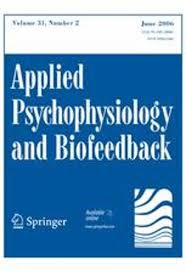Research Library
You can search for publications by selecting a category or keyword. All publications containing the selected category or keyword will be displayed below.
Categories
Keywords
Categories
Keywords
- Show all
- ADHD
- Anxiety/Panic
- Burnout
- Cancer
- Cardiovascular disease
- Chronic pain
- Cognitive function
- Cortisol/DHEA
- Costs
- Dementia
- Depressie
- Diabetes
- Global Coherence
- Hypertension
- Intuition & Consiousness
- Kids/Youth
- Leadership
- Meditation/Mindfulness
- Metabolic Syndrome
- Obesity/Eating disorder
- Pregnancy
- PTSD
- Resilience
- Schizophrenia
- Science HRV & Coherence
- Sleep quality & fatigue
- Social Coherence
- Stress
Heart rate variability biofeedback in a global study of the most common coherence frequencies and the impact of emotional states.

This global study analyzed data from the largest dataset ever studied in the Heart Rate Variability (HRV) biofeedback field, comprising 1.8 million user sessions collected from users of a mobile app during 2019 and 2020. We focused on HRV Coherence, which is linked to improved emotional stability and cognitive function. Positive emotions reported by users were associated with higher Coherence scores and more stable HRV frequencies. In contrast, negative emotions exhibited lower scores and more dispersed frequency distributions.
read more...Comparing the Effects of Square, 4–7-8, and 6 Breaths per Minute Breathing Conditions on Heart Rate Variability, CO2 Levels, and Mood.

Square and 4–7-8 breathing are popularly promoted by psychotherapists but have little empirical support. We hypothesized that breathing at 6 breaths per minute (bpm) would improve HRV, reduce blood pressure, and improve mood more than either square or 4–7-8 breathing. We also hypothesized square and 4–7-8 breathing would increase end-tidal CO2(PETCO2). Eighty four college students (60% female) had HRV measured at baseline and during 1) square breathing, 2) 4–7-8 breathing, 3) 6 bpm with a 4:6 inhale-to-exhale ratio, and 4) 6 bpm with
read more...Do Longer Exhalations Increase HRV During Slow-Paced Breathing?

Slow-paced breathing at an individual’s resonance frequency (RF) is a common element of heart rate variability (HRV) biofeedback training (Laborde et al. in Psychophysiology 59:e13952, 2022). Although there is strong empirical support for teaching clients to slow their respiration rate (RR) to the adult RF range between 4.5 and 6.5 bpm (Lehrer & Gevirtz, 2014), there have been no definitive findings regarding the best inhalation-to-exhalation (IE) ratio to increase HRV when breath ing within this range.
read more...Following the Rhythm of the Heart: HeartMath Institute’s Path to HRV Biofeedback

This paper outlines the early history and contributions our laboratory, along with our close advisors and collaborators, has made to the field of heart rate variability and heart rate variability coherence biofeedback. In addition to the many health and wellness benefits of HRV feedback for facilitating skill acquisition of self-regulation techniques for stress reduction and performance enhancement, its applications for increasing social coherence and physiological synchronization among groups is also discussed. Future research directions and applications are also suggested.
read more...The effect of HRVB training on young soccer players' skill performance

ABSTRACT
The present study aimed to evaluate the influence of heart rate variability biofeedback (HRVB) training on selected soccer skills performance. The objective of this study was to evaluate the effect of HRVB on soccer players’ reactive motor skill test (RMST), sprint time, reactive agility, passing time, and passing accuracy. Participants of this study were Malaysian high school soccer players (n = 32), with mean age of 15.21 ± 1.85, who were assigned randomly into two groups: Experimental groups and control group. Each group had 16
Heart rate variability biofeedback in chronic disease management: A systematic review

Background: Heart rate variability biofeedback (HRVB) is a non-pharmacological intervention used in the management of chronic diseases.
Method: A systematic search was performed according to eligibility criteria including adult chronic patients, HRVB as main treatment with or without control conditions, and psychophysiological outcomes as dependent variables.
Results: In total, 29 articles were included. Reported results showed the feasibility of HRVB in chronic patients without adverse effects.
One-Minute Deep Breathing Assessment and its Relationship to 24-h Heart Rate Variability Measurements

Background: Heart rate variability (HRV), the change in the time intervals between successive pairs of heartbeats, is influenced by interdependent regulatory systems operating over different time scales to adapt to psychological challenges and environmental demands. Low ageadjusted HRV is predictive of upcoming health challenges in healthy people as well as a wide range of diseases in patients and correlates with allcause mortality. 24h HRV recordings are considered the “gold standard” and have greater predictive power on health risk
read more...Comparative study of the impact of active meditation protocol and silence meditation on heart rate variability and mood in women

Aim: The aim of this study was to understand the impact of an active meditation protocol on heart rate variability (HRV) and mood in women as compared to breath-focused silence meditation. Materials and Methods: Women experienced two different practices of 20 min each: (a) control group: silence meditation focusing on breath and (b) experiment group: active meditation that included four activities, each lasting for 5 minutes – (1) simple humming, (2) coherent heart-focused breathing with 5s of inhalation and 5s of exhalation, (3) coherent
read more...Heart Rate Variability Biofeedback Improves Emotional and Physical Health and Performance: A Systematic Review and Meta Analysis

We performed a systematic and meta analytic review of heart rate variability biofeedback (HRVB) for various symptoms and human functioning. We analyzed all problems addressed by HRVB and all outcome measures in all studies, whether or not relevant to the studied population, among randomly controlled studies. Targets included various biological and psy-chological problems and issues with athletic, cognitive, and artistic performance. Our initial review yielded 1868 papers, from which 58 met inclusion criteria. A significant small to moderate effect size was found favoring HRVB, which does not differ from that of other effective treatments. With
read more...Heart Rate Variability, Health and Well-Being: A Systems Perspective

The development of a new tool, analytic device, or approach frequently facilitates rapid growth in scientific understanding, although the process is seldom linear. The study of heart rate variability (HRV) defined as the extent to which beat-to-beat variation in heart rate varies, is a rapidly maturing paradigm that integrates health and wellness observations across a wide variety of biomedical and psychosocial phenomena and illustrates this nonlinear path of development. The utility of HRV as an analytic and interventive technique goes far beyond its original application as a robust predictor of sudden cardiac death. This Research Topic aims to provide a conceptual
read more...Heart Rate Variability: New Perspectives on Assessment of Stress and Health Risk at the Workplace

Introduction: Cardiovascular diseases are the highest cause of death in the world. Many of these deaths may be workplace related. Long hours at work seem to be influencing the increased risks of heart diseases. Workplace stress can be defined as the “discrepancies between the physiological demands within a workplace and the inability of employees to either manage or cope with such work demands.” The varied nature and perception of stress are exemplified from literature that shows stress being either a stimulus, or a response, or a stimulus–
read more...Exploring a 1-Minute Paced Deep-Breathing Measurement of Heart Rate Variability as Part of a Workers' Health Assessment

Low heart rate variability (HRV) is related to health problems that are known reasons for sick-leave or early retirement. A 1-minute-protocol could allow large scale HRV measurement for screening of health problems and, potentially, sustained employability. Our objectives were to explore the association of HRV with measures of health. Cross-sectional design with 877 Dutch employees assessed during a Workers’ Health Assessment. Personal and job characteristics, workability, psychological and mental problems, and lifestyle were measured with questionnaires. Biometry was measured (BMI, waist circumference, blood pressure, glucose, cholesterol). HRV was assessed with a 1-minute paced deep-breathing protocol and expressed as mean heart rate range (MHRR). A low MHRR indicates a higher health risk.
read more...An Overview of HRV Norms and Metrics

Healthy biological systems exhibit complex patterns of variability that can be described by mathematical chaos. Heart rate variability (HRV) consists of changes in the time intervals between consecutive heartbeats called interbeat intervals (IBIs). A healthy heart is not a metronome. The oscillations of a healthy heart are complex and constantly changing, which allow the cardiovascular system to rapidly adjust to sudden physical and psycho-logical challenges to homeostasis. This article briefly reviews current perspectives on the mechanisms that generate 24 h, short-term (~5 min), and ultra-short-term (<5 min) HRV, the importance of HRV, and its implications
read more...Validity of (Ultra-)Short Recordings for Heart Rate Variability Measurements

Objectives
In order to investigate the applicability of routine 10s electrocardiogram (ECG) recordings for time-domain heart rate variability (HRV) calculation we explored to what extent these (ultra-)short recordings capture the “actual” HRV.
Methods
The standard deviation of normal-to-normal intervals (SDNN) and the root mean square of successive differences (RMSSD) were measured in 3,387 adults. SDNN and RMSSD were assessed from (ultra)short recordings of 10s(3x), 30s, and 120s and compared to 240s–300s (gold
Heart Rate Variability: New Perspectives on Physiological Mechanisms, Assessment of Self-regulatory Capacity, and Health Risk

Heart rate variability, the change in the time intervals between adjacent heartbeats, is an emergent property of interdependent regulatory systems that operates on different time scales to adapt to environmental and psychological challenges. This article briefly reviews neural regulation of the heart and offers some new perspectives on mechanisms underlying the very low frequency rhythm of heart rate variability. Interpretation of heart rate variability rhythms in the context of health risk and physiological and
read more...A healthy heart is not a metronome: an integrative reviewof the heart's anatomy and heart rate variability

Heart rate variability (HRV), the change in the time intervals between adjacent heartbeats,is an emergent property of interdependent regulatory systems that operate on different time scales to adapt to challenges and achieve optimal performance. This article briefly reviews neural regulation of the heart, and its basic anatomy, the cardiac cycle, and the sinoatrial and atrioventricular pacemakers. The cardiovascular regulation center in the medulla integrates sensory information and input from higher brain centers, and afferent
read more...Cardiac coherence, self-regulation, autonomic stability, and psychosocial well-being

The ability to alter one’s emotional responses is central to overall well-being and to effectively meeting the demands of life. One of the chief symptoms of events such as trauma, that overwhelm our capacities to successfully handle and adapt to them, is a shift in our internal baseline reference such that there ensues a repetitive activation of the traumatic event. This can result in high vigilance and over-sensitivity to environmental signals which are reflected in inappropriate emotional responses and autonomic nervoussystem dynamics. In this article
read more...Heart rate variability biofeedback: how and why does it work?

In recent years there has been substantial support for heart rate variability biofeedback (HRVB) as a treatment for a variety of disorders and for performance enhancement (Gevirtz,2013). Since conditions as widely varied as asthma and depression seem to respond to this form of cardiorespiratory feedback training, the issue of possible mechanisms becomes more salient.The most supported possible mechanism is the strengthening of homeostasis in the baroreceptor (Vaschillo et al., 2002;Lehrer et al., 2003). Recently, the effect on the vagal afferent
read more...The Effects of Emotions on Short-Term Power Spectrum Analysis of Heart Rate Variability

This study utilizes heart rate variability analysis to examine a new method of intentionally shifting emotional states, and demonstrates that positive emotions lead to alterations in sympathovagal balance that may be beneficial in the treatment of hypertension. Anger, on the other hand, was shown to significantly increase sympathetic activation.
read more...The Effects of Emotions on Short-Term Power Spectrum Analysis of Heart Rate Variability

Introduction: This study utilizes HRV analysis to examine a new method of intentionally shifting emotional states, and demonstrates that positive emotions lead to alterations in sympathovagal balance that may be beneficial in the treatment of hypertension. Anger, on the other hand, was shown to significantly increase sympathetic activation.
Summary: Salivary IgA, heart rate and mood were measured in thirty individuals before and after experiencing care or anger. Two methods
